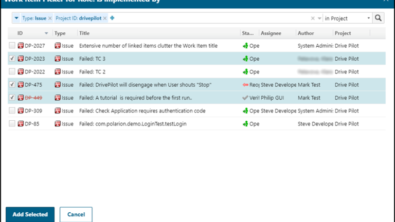Polarion ALM 17.1 – What’s New and Noteworthy

 Polarion: 17.1
Polarion: 17.1
Summer is rolling in and before the vacation season gets well underway, it’s time to announce the release of Polarion ALM version 17.1 – the first service release of the version 17 cycle – and as usual, to give you a summary of what our development team delivers in the release. So without more ado, let’s jump in.
Resource Traceability
Our development team continued with and delivered several planned enhancements to this feature.
Resource Traceability for Cluster Deployment
It is now possible to ensure high-availability of Resource Traceability links by setting up a Resource Traceability server on a standalone instance of Polarion ALM. For that, a few adjustments in configuration are required, which are documented in the Help. See the Administrator’s Guide part, under chapter 15: “Configuring Repositories”: Configuring Resource Traceability.
Render Linked Resources API
The rendering API for Resource Traceability was improved to cover more scenarios and also render faster. Among other things, you can now –
- Get all Work Items in a project that contain Linked Resources
- Get a list of Linked Resources for a group of Work Items
- Get a list of Linked Resources by Work Item IDs
You can find documentation in the Polarion ALM SDK.
Easy Querying for Items Having Linked Resources
A new visual query element “Has Linked Resources” is now available in the Work Items table and on widgets with data set parameters, enabling users to search for and track the code coverage easily.
Export Control
Quite a few customers have been asking for the ability to add watermarks to PDF documents exported from their Polarion ALM system, and the ability to impose high-level controls that enforce their organization’s policies for information sharing. Polarion ALM 17.1 delivers new capabilities for such export controls.
Watermarks for PDF Export
If you need to comply with export control regulations or just follow internal policies of you organization that require it, you can configure the PDF exporter to render an image-based watermark when users export Documents or Pages to PDF.
You can set this up in both global and project scopes in the “Documents & Pages: PDF Export Configuration” topic of Administration, along with other export options. For details, see the new Help topic in Administrator’s Guide: “Configuring Export Watermarks”.
Overriding the Export Configuration to Enforce Policy
There is new extension point and API available for companies to enforce particular export settings (header, footer, watermark image) for PDF exports, overriding the configuration and/or modification by users during an export operation. When used, a message appears in the Export to PDF dialog.
Developers: see the extension point com.polarion.alm.tracker.exportPreprocessors and the Java interface IPObjectsExportConfigurationPreprocessor.
There are similar controls available in the API to enforce use of a particular export template for Word and Excel round-trip exports initiated by all users. When implemented, the Round-trip: Export Document dialog shows a message to users : “The selected template may be substituted with one that complies with company policy.” Developers, see the extension point com.polarion.alm.tracker.exportPreprocessors and the Java interface IExportConfigurationPreprocessor.
Attachment Previews
We continued to work on support for direct insertion of attachments into rich text fields of Work Items, etc. In version 17.1 you’ll notice that the small icons from our first iteration are now replaced with larger icon-like previews. To have real previews you need to install a preview engine. Polarion ALM 17.1 can be configured to leverage Teamcenter Visualization Convert application or you can configure Polarion ALM to use a custom engine similar to the way an OLE converter is now configured.
Whenever an image or attachment is inserted into a Document, Live Report Page or rich text field of Work Items, it is automatically shrunk to the width of the Document (even outside of the Document). Non-image attachments which are not Visio diagrams are shrunk to 1/3 of the Document width.
Also, it is now possible to update an attachment through full-screen preview using the new Update button:
Import Wizard for IBM DOORS
The Polarion Connector for IBM DOORS® can import and entire DOORS project into Polarion ALM. The Connector works with all Doors 9.x versions running on Windows. (It will still work if Polarion ALM is run on a Linux machine.) The Connector imports the following:
- All modules selected for import as a LiveDoc Document
- All requirements in the modules
- All links between requirements in the same or different modules
- All the configured requirement attributes, including tables
Once imported, the Connector can be used to continuously import updates made within the DOORS modules. For additional info, see the Administrator’s Guide component of Help: Configuring Connectors > Importing an IBM DOORS Project.
Performance & Scalability Improvements
As we follow our development roadmap to add and enhance features, we are always mindful of the need for scalability and performance. In this release, we deliver the following in this area:
- Improved concurrency of login in cluster – In order to support the quick ramp-up of our scalability tests, the login and logout operations in a cluster under stress were significantly improved. Our test shows that 1000 users can log in within 600 seconds with average response time of 127 ms, which is 10 times faster than in previous versions.
- Parallel creation of Activities and Notifications – Notifications and Activities are now created by multiple parallel threads, ensuring that cluster nodes can keep up with a high number of changes without delaying the delivery of these objects. Also, the adding of new Activities to the storage has been optimized to prevent lock contention in a cluster. Our test shows that performing 240,000 operations in 140 minutes resulted in maximum 27 seconds delay in Notification processing.
- On-demand loading of derived linked revisions – The on-demand loading of the derived linked revisions field for Work Items reduces the total number of Lucene searches, which may have stressed the garbage collection significantly in the previous releases.Our tests show that total time spent in Lucene search decreased by 47% and average transaction duration is lower by 64%.
- Faster save of Document when creating many new Work Items – Adding multiple Work Items in a Document and saving the changes now takes less time. The save of Document when creating 30 new Work Items has improved by approximately 20%, according to our tests.
- Faster startup of Polarion – Tomcat startup performance was improved by about 60%, resulting in faster restarts and shorter downtime.
Additional Notable Enhancements
- WYSIWYG overwriting Work Items in Document Editor – When overwriting a referenced Work Item in Documents, the new Work Item is populated with values from the overwritten Work Item. So the user starts editing the data exactly as they were on the original item and has full understanding of what data will be saved. The handling of fields during the overwrite action has been aligned with the duplicate action, so now some fields are not being copied during the overwrite, namely: Approvals, Author, Comments, Created, Work Records, Time Spent, Remaining Estimate, Status, and Linked Revisions.
- New Agile Software Project template – Redesign of template Agile Software Project implements all reports in the new LiveReport technology, providing a number of useful examples how to address typical needs for customization.
- Manage restrictions from Variants projects – Cross-project Variants Management was improved to support overwriting and modification of referenced Work Items in a generated Variant document in a different project without losing Restriction information. You can now modify the restriction in a Variant document and merge changes back to Master document, if needed.
- Authentication fail-over for Kerberos single sign-on – Polarion ALM now allows bypassing the Kerberos single sign-on authentication if a user is not a member of the domain (an external stakeholder is accessing Polarion via VPN, for example). With proper configuration, such users still log in via the standard login dialog using credentials from LDAP.
- Use thumbnail provided by ReqIF – When importing ReqIF documents that contain the preview of an embedded OLE object, Polarion ALM uses the embedded preview instead of generating new one.
- Cluster load balancing for web services – Polarion ALM’s web services client was enhanced to support load balancing in a cluster, so users of our web services client should now connect via the load balancer to benefit from high-availability and load-balancing.
- Trigger thread dump from administration – Administrators can initiate capturing of a thread dump from within Administration, which is then recorded to Polarion log files in order to simplify troubleshooting of potential performance issues. Automated capture of thread dumps for long-running transactions is disabled by default.
- In-house building of bundled software components – The bundled Apache and Subversion distributions are now being built in-house rather than taken from Apache Haus, as in previous releases. By building these binaries in-house we can guarantee that no potential malicious code is part of the Apache and Subversion distributions.
- Curator library updated – The Curator library is core technology for the synchronization of nodes and operations in a Polarion cluster. The library has been updated to latest version, which addresses many bug fixes and enhancements, and which results in improved stability of cluster deployment.
What Next?
Version 17.1 is an update for all Polarion ALM products. It is free to all customers with a current maintenance subscription. You can download the update distribution at: https://polarion.plm.automation.siemens.com/downloads/update.
If you would like to evaluate this release before updating a production installation, visit https://polarion.plm.automation.siemens.com/downloads, download the product of your choice, install it on any available computer and use the built-in 30-day evaluation license.
On behalf of our entire team, thanks for using Polarion ALM solutions.
Comments
Leave a Reply
You must be logged in to post a comment.








Unfortunately the screen shot images are not visible anymore. Would be nice to see them for better understanding the topics.
Cheers Sven